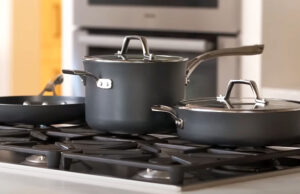As an Amazon Associate, I earn from qualifying purchases at no extra cost to you.
How to Measure Dishwasher the Right Way (Expert Guide)
When I first bought a dishwasher, I assumed measuring it would be simple. I quickly realized that a few inches made all the difference between a perfect fit and a tight squeeze. The tiny gaps behind cabinets, the uneven floors, even the water lines—everything matters. Measuring carefully can save hours of frustration, extra trips to the store, and a lot of stress. I started jotting down tricks I wish I knew before, and they work every time.
Key Takeaways: To measure a dishwasher, first clear the space and check width, height, and depth carefully. Use a tape measure for exact dimensions, including gaps for water lines and ventilation. Note any obstacles like cabinet handles or pipes. Measure floor levelness and wall straightness. Check door clearance when open. Consider standard vs. compact dishwasher sizes. Record all numbers for reference when buying. Always double-check before purchasing. These steps make installation smooth and prevent mistakes.
Measure the Width Accurately
The width is usually the trickiest part. Many people forget to account for cabinet trim or slight protrusions. I once measured only the appliance slot and ignored the handles—it didn’t fit at all. Always measure from the inner edges of the opening, and then again including cabinet trim. Tape measures can bend or shift, so keep the tape snug and straight.
It helps to measure at multiple points. Floors can slope slightly, or cabinets may not be perfectly parallel. I like to measure at the top, middle, and bottom. If numbers differ, use the smallest width for safety. A tight fit can cause scratches or prevent full installation.
Consider obstacles too. Water lines, electrical outlets, or even floor molding can reduce effective width. Sometimes moving a pipe just an inch can make a huge difference. Don’t forget to check if your kitchen floor has any irregularities that might reduce space. A little planning here saves big headaches later.
A final tip: write down your measurements immediately. I always take a photo of the tape measure reading too, just in case I forget. Comparing them with dishwasher specs avoids the stress of returning appliances.
- Measure inner edges first, include cabinet trim
- Check top, middle, bottom for variations
- Account for pipes, outlets, and molding
- Record and double-check measurements
Measure the Height Carefully
Height is another critical dimension people overlook. Most standard dishwashers fit under countertops, but some counters are slightly higher or lower. I remember struggling when my kitchen floor had a small slope—it made a 34-inch slot too short at one end. Measure from the floor to the underside of the counter.
Also, account for leveling feet. Dishwashers usually have adjustable legs, and these can add or reduce an inch or two. I always extend them fully and measure, then note the minimum and maximum heights. It’s like building a safety range before shopping.
Check the door clearance too. Dishwashers swing forward when open, and the door can hit drawers or cabinets nearby. I once had to push a drawer back just a little to allow the door to open fully. Taking a quick mock-up with cardboard can help visualize it.
Finally, consider flooring changes. If you plan to add tile or replace flooring, measure after the new floor is in place. This avoids surprises when the dishwasher suddenly won’t fit.
- Measure floor to counter underside
- Include adjustable legs for height range
- Check door clearance with surrounding cabinets
- Measure after flooring changes
Measure the Depth Precisely
Depth can make or break a dishwasher installation. Some dishwashers stick out if you don’t measure carefully, ruining your countertop lines. I usually measure from the wall to the front edge of the cabinet. Don’t forget any molding or backsplash.
Consider hoses and connections. Water and drain hoses need space behind the dishwasher. I once installed a machine only to realize the drain pipe blocked it by half an inch. Always measure with hoses in mind.
Dishwasher depth also affects the door swing. If the machine sticks out too far, it can bump against an island or doorway. I like to simulate the opening with a cardboard cutout—it’s surprisingly useful.
Finally, account for installation tolerances. A small gap at the back can allow air circulation and prevent vibration noises. I learned this after my first dishwasher rattled slightly against the wall. A tiny space behind the unit keeps it quiet and stable.
- Measure wall to cabinet front accurately
- Include molding and backsplash
- Allow space for hoses and connections
- Simulate door swing with a cardboard mockup
Check for Obstructions
Obstructions can silently ruin measurements. I’ve seen cabinets with hidden pipes, electrical outlets, or floor vents that make a perfect slot too small. Walking behind the dishwasher area and looking carefully is key.
Also, think about cabinet handles or drawers nearby. Even a half-inch protrusion can prevent proper installation. I keep a small level and tape handy to mark problem spots. Sometimes a minor adjustment solves the whole issue.
Doors, walls, and appliances around the space can create hidden issues. When I installed my last dishwasher, a tiny lip on the floor forced me to adjust the leveling feet. It worked perfectly after a small tweak.
Finally, don’t forget the backsplash. Some dishwashers need a little space to clear it. Even an inch can save a lot of frustration. I usually keep a checklist to make sure nothing is overlooked before buying.
- Inspect for pipes, outlets, and vents
- Check cabinet handles and drawer clearance
- Mark problem spots with tape
- Leave small gaps for clearance
Measure Floor Levelness
Floor levelness affects dishwasher stability and performance. I once installed a dishwasher on a slightly sloped floor, and it kept vibrating during cycles. A simple bubble level can save a lot of headaches. Measure front to back and side to side.
If the floor isn’t level, consider shims. I usually use thin plastic shims under the dishwasher feet to balance it perfectly. Some adjustable legs allow minor leveling adjustments, but shims help for bigger slopes.
Uneven floors can also affect water drainage. I learned this after noticing standing water in the bottom tray. Leveling before installation ensures water flows properly and prevents long-term damage.
Finally, double-check after placing the dishwasher in its slot. I use a level again to confirm. It feels like a small step, but it prevents rattling, leaks, and annoying vibrations.
- Check front-to-back and side-to-side level
- Use shims for uneven floors
- Consider water drainage flow
- Double-check after placement
Double-Check All Measurements
Double-checking is crucial. I’ve made the mistake of measuring only once, only to discover my dishwasher wouldn’t fit. Measure each dimension twice, preferably on different days.
Compare your numbers with manufacturer specs. Some dishwashers list minimum and maximum clearances. I once chose a model right at the slot’s limit, and even a tiny measurement error would have blocked installation.
Think about installation tools and space for movement. Dishwashers need some wiggle room for hoses, connectors, and leveling adjustments. I like to keep a ½-inch buffer on every side.
Finally, review all numbers before buying. A simple checklist with width, height, depth, obstacles, and floor level prevents stress. I keep mine on my phone and tape it in the kitchen—it’s saved me from multiple returns.
- Measure each dimension twice
- Compare with manufacturer specs
- Allow wiggle room for installation
- Keep a checklist of all measurements
Final Thoughts
Measuring a dishwasher carefully saves time, money, and frustration. Every inch counts, and skipping even small details can create installation problems. Following these steps ensures a smooth fit and avoids surprises. Take your time, check twice, and think about door swing, floor level, and obstacles. Your dishwasher will fit perfectly and work efficiently for years.
| Measurement Aspect | How to Measure | Tips & Notes |
|---|---|---|
| Width | Inner cabinet edges & trim | Measure top, middle, bottom; note smallest width |
| Height | Floor to counter, including leveling feet | Check door clearance and floor changes |
| Depth | Wall to cabinet front | Include backsplash and hoses; simulate door swing |
| Floor Levelness | Front-back & side-side using bubble level | Use shims for uneven floors |
| Obstacles | Pipes, outlets, handles | Mark problem spots; allow small gaps |
| Clearance for Connections | Water/drain hoses, electrical | Keep extra space behind dishwasher |
| Door Swing | Measure space required for full door opening | Use cardboard to visualize swing |
| Double-Check All | Re-measure all dimensions | Compare with manufacturer specs and allow buffer |
Frequently Asked Questions (FAQs)
Is it necessary to measure the dishwasher space before buying?
Yes, measuring before buying is essential. Even minor differences can make a dishwasher too tight or impossible to install. I’ve seen people assume standard sizes always fit, but kitchen spaces vary. Measuring ensures the dishwasher fits perfectly, avoids returns, and saves frustration. Include width, height, depth, door swing, and obstacles like pipes or outlets. Double-checking gives peace of mind before purchase.
Can I install a dishwasher on an uneven floor?
You can, but it requires adjustments. Uneven floors can cause vibrations, leaks, or poor drainage. I usually use shims under dishwasher feet to balance it. Adjustable legs also help for small slopes. Always check with a level front-to-back and side-to-side after placement. Taking these precautions ensures stability and protects your appliance for years.
Do I need to measure the clearance for water and drain hoses?
Absolutely. Hoses need space behind the dishwasher. I once blocked my drain pipe by half an inch because I didn’t measure. Always include extra room for hoses and connectors. Leaving a small buffer prevents kinks and ensures smooth installation. Visualizing space with cardboard or tape can help before buying.
Is it okay to rely on manufacturer dimensions alone?
Not completely. Manufacturer dimensions often assume perfect conditions. Real kitchens may have uneven floors, trim, or obstacles. I always measure the space myself and compare with specs. This prevents surprises and ensures a proper fit, especially in older kitchens.
Can cabinet handles affect dishwasher installation?
Yes, even small handles can block installation. I learned this the hard way when my new dishwasher hit a drawer handle. Always measure from handles to the dishwasher slot. Sometimes minor adjustments like moving a handle or choosing a smaller model solves the problem.
Do I need to measure door swing space?
Definitely. The door needs room to open fully without hitting cabinets or walls. I like to simulate with cardboard. Even a small obstruction can prevent proper loading or unloading. Always visualize full door swing before buying.
Is measuring only once enough?
No, always measure twice. I’ve made mistakes measuring only once and had to return a dishwasher. Measuring on different days and double-checking ensures accuracy. Include width, height, depth, and any obstacles.
Can I adjust a dishwasher if it doesn’t fit perfectly?
Sometimes small adjustments help. Adjustable legs, shims, or minor repositioning of hoses can fix small issues. However, significant mismatches require a different model. Measuring carefully upfront reduces the need for adjustments later.



